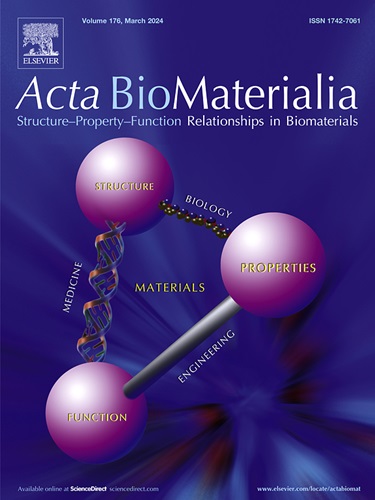Recombinant cytokine bioconjugates with degradable nanogel substrates for macrophage immunotherapy
IF 9.4
1区 医学
Q1 ENGINEERING, BIOMEDICAL
引用次数: 0
Abstract
Cytokines are potent endogenous modulators of innate immunity, making them key mediators of macrophage plasticity for immunotherapy. However, the clinical translation of recombinant cytokines as therapeutics is limited by systemic side effects, caused by cytokines’ pleiotropy, potency, and non-specific biodistribution following systemic dosing. We developed a cytokine delivery platform utilizing poly(acrylamide-co-methacrylic acid) synthetic nanogels as a biodegradable substrate for conjugated recombinant cytokines (i.e., IFNγ, IL4, or IL10), called Synthetic Nano-CytoKines or “SyNK”. We evaluated the phenotypic response of macrophages to these conjugates following prophylactic or therapeutic dosing, in the presence or absence of soluble inflammatory signals. Our data confirmed that SyNK is highly cytocompatible with murine macrophages, preserves the activity of conjugated recombinant cytokines to both macrophages and dendritic cells, and minimizes systemic exposure to freely soluble recombinant cytokines. Intrinsic activity of the nanomaterial was modest, acting in combination with the conjugated cytokine, and resulted in unique phenotypes with IL4-SyNK and IL10-SyNK stimulation that could potentially be leveraged for therapeutic applications. We further demonstrated that RAW264.7 macrophages adopt distinct alternative phenotypes upon IL4 or IL10 stimulation in different classically polarizing microenvironments, as measured by spectral flow cytometry and secretome multiplex, which are similar for soluble recombinant cytokine and the corresponding SyNK. These findings offer a potential mechanism through which IL4 or IL10-SyNK can redirect the classically activated macrophage antigen presentation, T cell co-stimulation, or microenvironment regulatory functions for therapeutic purposes.
Statement of significance
Cytokines have been extensively investigated as immune therapies, but their clinical translation is limited by their systemic toxicity and frequent dosing regimens. Existing approaches have improved cytokine stability and local delivery but still face challenges in systemic administration and controlling immune response. We developed a cytokine delivery platform using biodegradable poly(acrylamide-co-methacrylic acid) nanogels to conjugate cytokines (e.g. IFNγ, IL4, or IL10) aimed at systemic macrophage immunotherapy. We show that our platform preserves cytokine activity and eliminates the release of free cytokine. We further explore, for the first time, how different stimuli in the macrophage environment influence their response to the cytokine bioconjugates. Our work provides thorough insights into macrophage plasticity and addresses key limitations of current strategies.

重组细胞因子与可降解纳米凝胶底物的生物偶联用于巨噬细胞免疫治疗。
细胞因子是先天免疫的有效内源性调节剂,是免疫治疗中巨噬细胞可塑性的关键介质。然而,重组细胞因子作为治疗药物的临床翻译受到全身副作用的限制,这些副作用是由细胞因子的多效性、效力和全身给药后的非特异性生物分布引起的。我们开发了一个细胞因子递送平台,利用聚(丙烯酰胺-共甲基丙烯酸)合成纳米凝胶作为结合重组细胞因子(即IFNγ, IL4或IL10)的可生物降解合成底物,称为合成纳米细胞因子或“SyNK”。在存在或不存在可溶性炎症信号的情况下,我们评估了巨噬细胞在预防性或治疗性给药后对这些偶联物的表型反应。我们的数据证实,SyNK与小鼠巨噬细胞具有高度的细胞相容性,保留了结合的重组细胞因子对巨噬细胞和树突状细胞的活性,并最大限度地减少了系统暴露于自由溶解的重组细胞因子。纳米材料的内在活性是适度的,与缀合的细胞因子联合作用,并导致独特的表型与IL4-SyNK和IL10-SyNK刺激,可能潜在地用于治疗应用。我们进一步证明RAW264.7巨噬细胞在不同的经典极化微环境中,在IL4或IL10刺激下呈现不同的表型,通过光谱流式细胞术和分泌组多重检测,这与可溶性重组细胞因子和相应的SyNK相似。这些发现提供了一种潜在的机制,通过这种机制,IL4或IL10-SyNK可以重新定向经典活化的巨噬细胞抗原呈递、T细胞共刺激或微环境调节功能,以达到治疗目的。重要性声明:细胞因子疗法作为免疫疗法已被广泛研究,但其临床转化受到其全身毒性和频繁给药方案的限制。现有的方法改善了细胞因子的稳定性和局部递送,但在全身给药和控制免疫反应方面仍然面临挑战。我们开发了一个细胞因子递送平台,使用可生物降解的聚(丙烯酰胺-共甲基丙烯酸)纳米凝胶结合细胞因子(如IFNγ, IL4或IL10),旨在系统巨噬细胞免疫治疗。我们发现我们的平台保留了细胞因子的活性,并消除了游离细胞因子的释放。我们首次进一步探讨了巨噬细胞环境中的不同刺激如何影响它们对细胞因子生物偶联物的反应。我们的工作为巨噬细胞的可塑性提供了深入的见解,并解决了当前策略的关键局限性。
本文章由计算机程序翻译,如有差异,请以英文原文为准。
求助全文
约1分钟内获得全文
求助全文
来源期刊

Acta Biomaterialia
工程技术-材料科学:生物材料
CiteScore
16.80
自引率
3.10%
发文量
776
审稿时长
30 days
期刊介绍:
Acta Biomaterialia is a monthly peer-reviewed scientific journal published by Elsevier. The journal was established in January 2005. The editor-in-chief is W.R. Wagner (University of Pittsburgh). The journal covers research in biomaterials science, including the interrelationship of biomaterial structure and function from macroscale to nanoscale. Topical coverage includes biomedical and biocompatible materials.
 求助内容:
求助内容: 应助结果提醒方式:
应助结果提醒方式:


